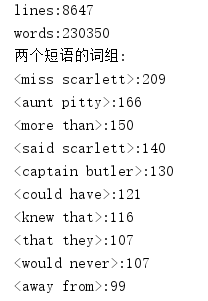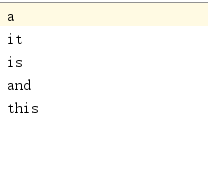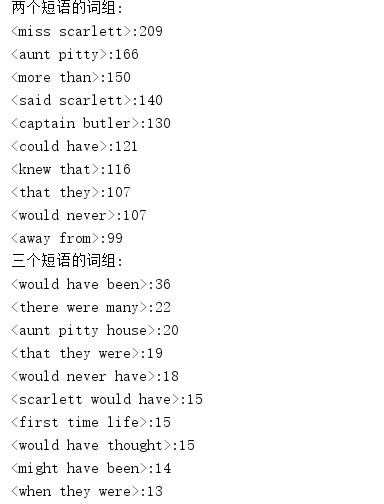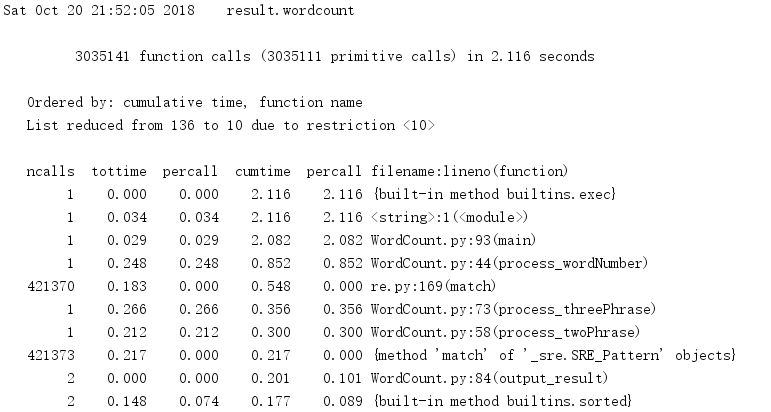一、基本信息
作业地址:https://edu.cnblogs.com/campus/ntu/Embedded_Application/homework/2088
项目git地址:https://gitee.com/ntucs/PairProg/tree/SE032_033/
结对成员:1613072032 赵亦明
1613072033 王楠楠
二、项目分析
2.1 程序运行模块(方法、函数)介绍
2.2.1 读取文件到缓冲区
1 def process_file(dst): # 读文件到缓冲区 2 try: # 打开文件s 3 d = open(dst, "r") 4 except IOError as s: 5 print(s) 6 return None 7 try: # 读文件到缓冲区 8 bvffer = d.read() 9 except: 10 print('Read File Error!') 11 return None 12 d.close() 13 return bvffer
2.1.2 统计文件的有效行数
1 def process_rowCount(bvffer): # 计算文章的行数 2 if bvffer: 3 count = 1 4 for word in bvffer: # 开始计数 5 if word == '\n': 6 count = count + 1 7 print("lines:{:}".format(count)) 8 f = open('result.txt', 'w') 9 print("lines:{:}".format(count),file=f) 10 f.close()
2.1.3 统计文件的单词总数
1 def process_wordNumber(words): 2 if words: 3 wordNew = [] 4 words_select = '[a-z]{4}(\w)*' 5 for i in range(len(words)): 6 word = re.match(words_select, words[i]) # 如果不匹配,返回NULL类型 7 if word: 8 wordNew.append(word.group()) 9 print("words:{:}".format(len(wordNew))) 10 f = open('result.txt', 'a') 11 print("words:{:}".format(len(wordNew)),file=f) 12 f.close() 13 return wordNew
2.1.4 输出频率最高的前10个词组
1 def output_result(word_freq): 2 if word_freq: 3 sorted_word_freq = sorted(word_freq.items(), key=lambda v: v[1], reverse=True) 4 for item in sorted_word_freq[:10]: # 输出 Top 10 的单词 5 print("词:%-5s 频:%-4d " % (item[0], item[1]))
2.1.5 停用词模块
1 def process_twoPhrase(words): 2 useless_twoPhrase =['they were','would have','there were','have been','that would'] 3 words_group = [] 4 for i in range(len(words) - 1): 5 str = '%s %s' % (words[i], words[i + 1]) 6 words_group.append(str) 7 word_freq = {} 8 for word in words_group: 9 if word in useless_twoPhrase: 10 continue 11 else: 12 word_freq[word] = word_freq.get(word, 0) + 1 # 将词组进行计数统计 13 return word_freq 14 15 16 def process_threePhrase(words): 17 words_group = [] 18 for i in range(len(words) - 2): 19 str = '%s %s %s' % (words[i], words[i + 1], words[i + 2]) 20 words_group.append(str) 21 word_freq = {} 22 for word in words_group: 23 word_freq[word] = word_freq.get(word, 0) + 1 # 将词组进行计数统计 24 return word_freq
2.1.6 高频词组模块
1 def output_result(word_freq): 2 if word_freq: 3 sorted_word_freq = sorted(word_freq.items(), key=lambda v: v[1], reverse=True) 4 for item in sorted_word_freq[:10]: # 输出 Top 10 频率高的 5 print("<{:}>:{:}".format(item[0], item[1])) 6 f = open('result.txt','a') 7 print("<{:}>:{:}".format(item[0], item[1]), file=f) 8 f.close()
2.1.7 主函数
1 if __name__ == "__main__": 2 # 把分析结果保存到文件中 3 cProfile.run("main()", filename="result.wordcount") 4 p = pstats.Stats("result.wordcount") 5 p.strip_dirs().sort_stats("calls").print_stats(10) 6 p.strip_dirs().sort_stats("cumulative", "name").print_stats(10) 7 p.print_callers(0.5, "process_transform") 8 p.print_callers(0.5, "process_rowCount") 9 p.print_callers(0.5, "process_wordNumber") 10 p.print_callers(0.5, "process_stopwordSelect") 11 p.print_callers(0.5, "process_twoPhrase") 12 p.print_callers(0.5, "process_threePhrase") 13 p.print_callers(0.5, "output_result") 14 p.print_callees("process_buffer")
2.2 程序算法的时间、空间复杂度分析
假设停词表文件有N个单词,待分析的文本单词集合有n个单词,根据两个for循环分析,则该模块的时间复杂度大概为O(N*n),又根据操作系统的空间内存重复调用可知,该模块的时间复杂度经优化后应该小于O(N*n)。
2.3 程序运行案例截图
2.3.1 task1

2.3.2 task2


三、性能分析
3.1 运行时间

3.2 性能图表

四、其他
4.1 结对编程时间开销
利用课余时间完成全部内容。团队成员共同讨论,查阅资料,完成代码部分的编写。同时,讨论代码中不完善的内容。
4.2 结对编程照片

五、事后分析与总结
5.1 简述结对编程时,针对某个问题的讨论决策过程
- 明确任务和分工。
- 针对需要完成功能,分享各自的想法,同时,进行对比,选取简单明晰或者性能好一点的方法。
- 完成基本代码编写后,再根据任务要求,检查运行结果,完善优化代码。
5.2 评价对方
王楠楠评价赵亦明:很有想法,动手能力强,认真负责,会主动交流想法。遇到问题时能一起分析并解决,也会认真听取他人的意见。
赵亦明评价王楠楠:学习能力很强,遇到问题时思路清晰,遇到不懂的会积极主动的查阅资料。
5.3 评价整个过程
整个过程是非常顺利和愉快的,过程大概经历一个星期左右,在确定过基本任务后,编写代码过程中,王楠楠提供想法,然后结合赵亦明的想法,最后由赵亦明编写代码,然后王楠楠最后再阅读检查,出现错误时,两个人都会交流想法,不断尝试,寻找解决办法,共同解决问题。平时也会一起交流想法,所以此次结对编程更加深了彼此的默契,同时也在结对过程中能够对比学习到彼此的优缺点,是一次很好的成长。
5.4 其他
结对编码是一个很好的过程,通过团队合作完成整个项目,可以避免单人完成时出现的考虑问题的片面性。